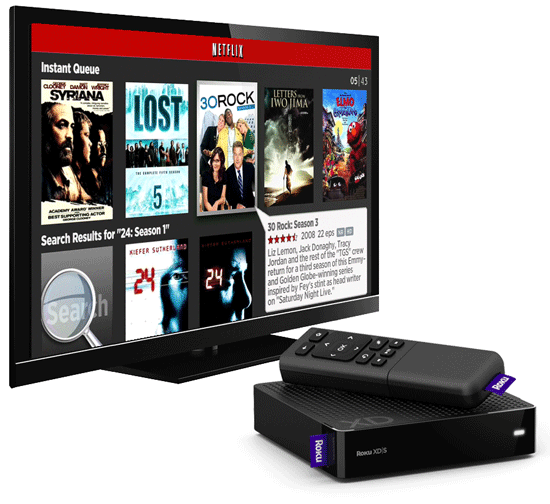 Thursday, September 30, 2010 at 4:03PM |
Thursday, September 30, 2010 at 4:03PM |  Visual Avenue
Visual Avenue 
Last week, Roku announced the release of its new set-top boxes. Starting at just $59.95 and along with a few new partnerships, Roku has effectively made itself a very serious contender in the set-top box market.
Pricing:
The Roku HD box starts at just $59.95 — a price that is almost half of the latest generation Apple TV. This low price point is significant because it makes the device affordable in a market where traditional (cable, satellite, etc.) content consumption prices are increasing. With Roku, a user also does not pay any additional content access fees. The highest model Roku — the XDS is priced at $99.99 — the same price as the Apple TV.
Features:
By and large, this particular update doesn’t introduce any ground breaking features. However, the Roku XDS model has the ability to display content from USB drives. This makes the device an excellent choice for presentation and demo purposes on the road.
Content:
Today, Roku supports more premium content than the Apple TV and for that matter, most set-top boxes. With access to Amazon Video on Demand, Pandora, Netflix and now Hulu Plus, the device can access a significant amount of premium content at very minimal cost ($20 per month for Hulu and Netflix). And, with the XDS‘ upcoming ability to play content from an attached drive makes the device even more attractive.
Apps:
As of this moment, the Apple TV doesn’t offer the ability to install Apps. Roku does. Roku calls their apps “channels.” And, the ability to create apps and market them on a growing platform is win-win for any media organization — small or large. Broadcast networks could potentially create their own channels and introduce new revenue streams.
Conclusion:
The new release by Roku is a huge leap forward, not just for the company, but for the set-top box market. Highly recommended.
Yesterday at the BlackBerry DEVCON conference, RIM announced the BlackBerry PlayBook. While other sites have covered the technology aspects of this announcement in detail, this device marks a new era for RIM:
- User experience: Take a look at the embedded video above in this post. The user-experience is significantly better than current BlackBerry devices. A step away from corporate.
- No network: The initial PlayBook is available as a WiFi only device. BlackBerry phones, even today, are not sold without a service contract. This is a huge step for BlackBerry / RIM and their first direct-to-consumer product.
- BlackBerry Internet Service (BIS): BIS is the backbone of BlackBerry devices across the world — ranging from BlackBerry Messenger to email services. To a certain extent, BIS is also carrier dependant and without a carrier, it will be interesting to see how the device works.
- Privacy: BlackBerry has also been battling with privacy issues in the Middle East and Asia. It will be interesting to see how this device will impact data-sharing agreements between authorities.
As an end user, I’ll definitely be reviewing the device and comparing it to the Apple iPad. Thus far in the demos, the BlackBerry PlayBook looks like a good concept.
For the past few weeks, I’ve been hard at work creating something that not many people across the world will see, but something that will still get coverage on primetime broadcasts in the United States. What is it? Multi-screen content for NBC News’ Education Nation. Through my employer, we were hired to do multi-screen video content for the event in 3 weeks worth of time. Calling that time-frame aggressive was being polite. We had to produce 2 significant pieces of content — one for a 14-screen installation and one for a 4-screen installation. Teams worked round-the-clock to gather high-quality images from across the country and we had to use robots to get our most crucial shots. Impressive? Yes. Hard-work? Yes. Worth it? Absolutely. If you’re in NYC and would like to see the exhibit, send me an email — aanarav [at] sareen [dot] tv and I’ll be your personal tour guide this week.
Production & Technology:
I’ve been creating content for 9 years professionally. During that time, I’ve worked for local public-access stations, advised broadcast networks strategically and played a crucial consulting role for companies that enable media to progress. However, the art of creation is still one of the most challenges components in entertainment. Digital media thus far has primarily been a technological advance, not a creative one. Working on the above project over 3 weeks round-the-clock makes the best digital media advocates realize that although we should be focusing on technological advances, we shouldn’t forget what most people are still interested in — big, beautiful and inspirational. Web doesn’t do that. Yet.
Content creators need to keep pushing the boundaries of what’s possible. Real-time instantaneous web broadcasts are fine. But, what’s the production quality? Digital-only content creators have littered the web with poor-quality content. There have never been financial incentives for poor quality work. Nor will there ever be. Despite technological advances, people still come back to watch content that inspires them. Content that looks good. As content creators, producers and marketers, we should be aiming for better.


Reader Comments